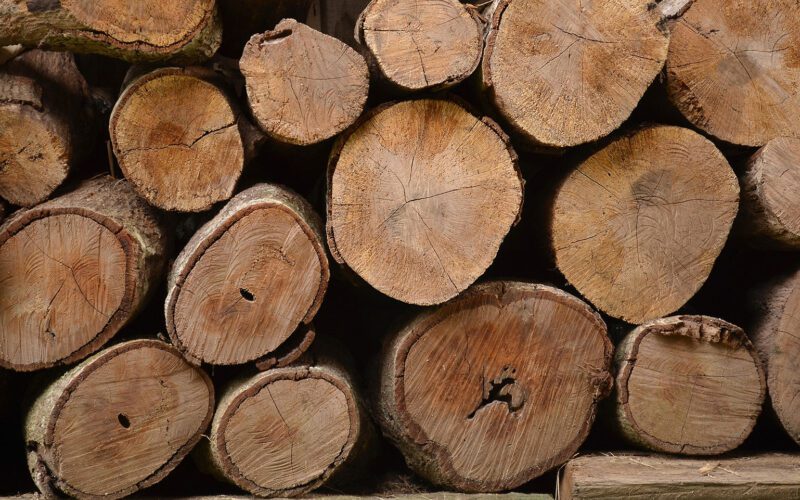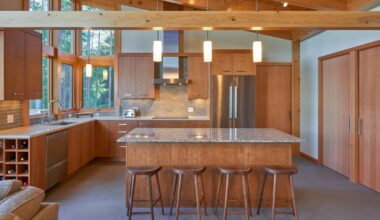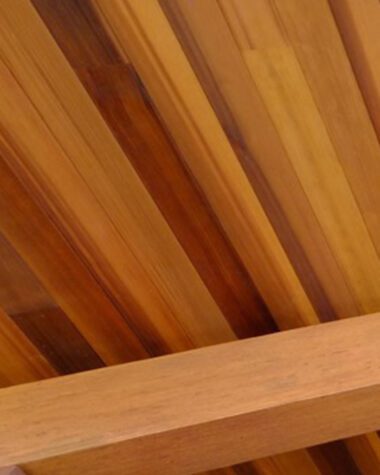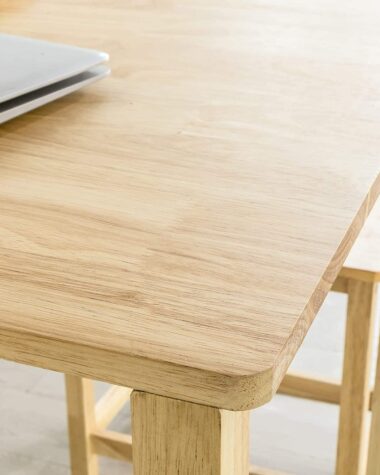Different wood types exist across the globe. This diversity in wood is rooted in the variations of trees. Trees may be of varying species, characteristics, and usability. To determine its family, a tree species is classified by its bark, leaves, seeds, fruits, etc. However, there are times when identifying a tree species through its wood type is more reliable, especially in choosing what’s best for your woodworking project.
Generally, there are three major classifications of wood type: softwood, hardwood, and manufactured wood. Each wood has its own natural beauty and unique properties that determine its own qualification for different uses.
Comparison Chart for Major Wood Types
Before going more specific in recognizing woods, you need to understand that woods have general characteristics based on what major types of wood they belong to. In this section, I will present to you the major differences between softwood, hardwood, and manufactured wood through a table chart.
| Categories | Hardwood | Softwood | Manufactured Wood |
| Growth | Hardwood trees are angiosperm, deciduous trees that grow more slowly (shed their leaves annually). | Softwood trees are conifers and gymnosperms. This means that they belong to evergreen trees that don’t lose their leaves. | Manufactured woods are products from any wood type. Thus, they do not naturally occur. |
| Density/ Durability | Hardwood types are durable, high-quality, and provide long-lasting use for a variety of functions. | Softwood wood type is less durable than hardwood because of its lower density. However, there are certain ‘hard’ softwood choices with a higher density, such as Juniper and Yew. | Manufactured woods are tougher than actual wood because it is constructed with multi-layers of wood. Thus, it is more resistant to dents and scratches. |
| Sustainability | Even though hardwoods aren’t as renewable as softwoods, hardwood timbers can be a good choice, given their durability. | Softwood trees are a very renewable source because they grow much faster than hardwood trees. | Manufactured woods have a high level of sustainability due to carbon sequestration. However, the majority of these products are non-biodegradable and do not have any carbon offset value due to synthetic adhesives. |
| Appearance | Hardwood timber is available in various colors and finishes, and it will go well in practically any environment with a contemporary design. | Softwood timber provides a beautiful, smooth finish. It is very workable and suited for a variety of styles and applications. | They have layered structures, which are the product of heating, gluing, and compressing wood. As a result, the product resembles a real wood surface. |
| Maintenance | Hardwood timber is simple to clean and scratch and dent repairs are simple due to its durability. | Softwood timber will need more frequent maintenance because it is less resilient than hardwood. | Engineered wood is simple to maintain, and will look great for many years. Poor upkeep and cleaning frequently result in issues with the functionality and appearance. |
| Cost | Due to their slower rate of growth and durable qualities, hardwoods are typically more expensive. However, because of their long lifespan and low maintenance requirements, they may be worthwhile in the long run. | Due to their quick growth and simpler availability, softwood timbers can be less expensive than hardwood timbers. | Humans create manufactured woods to maximize the benefits of solid wood for applications that are inexpensive. |
Wood Properties And Why They Matter
Every existing wood type can display both the same and different properties. It is crucial to understand how various types of wood might be used depending on their properties to avoid general errors and issues.
1. Color and Odor
Most trees or their woods are distinguished through their color and odor. For instance, walnut wood is characterized by its normal dark brown color. Likewise, teak wood has a golden yellow shade, especially if it is freshly cut. Some softwoods, like deodar wood and pine wood, typically have white colors.
Meanwhile, some woods are easily distinguished in terms of odor because they are popular for a certain odor they produce. For instance, teak woods have an aromatic smell, while pine woods smell like resin.
Do they matter?
Yes. The natural color of the wood matters, especially in wood finishing. For example, applying a natural cocoa brown stain to pine wood will give it a warmer golden brown look. It means that the natural color of the wood will affect the final color of the stained wood surface. The reason is that there are some colors that go well with specific wood colors, like dark wood.
Meanwhile, the wood scent also matters. There are many applications where the scent of wood is really important. For example, Cedar wood cabinets and ceiling chests utilize the natural repellent properties of cedar oil to keep pests. If you are making a storage box to store things that have their own taste and smell (cigar humidors, tea chests), you should consider the scent influence of the wood you use.
2. Moisture Content
Naturally, all woods are hygroscopic. This means that they absorb moisture from the atmosphere and release it into the atmosphere, depending on the water content of their cells relative to atmospheric moisture.
The moisture content of green wood is usually over 60% and can reach 120% in some wood species. A moisture content greater than 100% means that the wood contains more moisture than the dry wood material.
Does it matter?
Yes. Moisture content is an important consideration for woods. If you are in the field of woodworking, you should know the importance of properly drying your wood. For use in construction projects, the wood should be oven or air-dried to a moisture content of 9% to 14%.
But wood intended for indoor use, i.e., wood for carpentry, should have less than half that, or just 9 percent moisture. These levels of moisture are important to consider as the moisture level is inversely proportional to the strength of the wood. Strength is another property of any wood type.
3. Specific Gravity
Wood is a very light material, and its specific gravity is always less than 1 (the specific gravity of water). Interestingly, when wood tissue is compressed to such an extent that not even the slightest porosity remains in it, its specific gravity reaches 1.5 (i.e., it is heavier than water).
However, such compression is not possible as a natural process. Wood has a wide variation in specific gravity. Some woods have a specific gravity of 0.3, while others reach a specific gravity of 0.9. It depends on their structure and the presence of pores in them. The heartwood is heavier than the sapwood of the same tree. Similarly, hardwoods are always denser than softwoods.
Does it matter?
According to the US Department of Agriculture, specific gravity has a significant relationship with moisture content and density. Hence, it is the most important property of wood because knowing this allows us to predict more of the wood traits.
- Specific gravity (SG) determines the amount of structural material a wood can have to support strength, which is another property of wood.
- SG also refers to the ratio of the density of a particular substance to that of a reference substance occupying the same volume. In most cases, the reference substance is water. This is because the density, expressed in grams per cubic centimeter, is one. Minimizing moisture content creates more rings in trees in a given space. It means that the specific gravity is higher.
4. Density
Density is defined as the mass found in a unit volume of the material. Depending on the tree species and the environment in which it grows, wood has a different density. For reference of wood types with their respective densities, you may use a wood density chart.
Even the tree parts have different densities. For example, branches often have less dense wood than the trunk. Density can be measured at the same moisture content. To determine the moisture content of wood, divide the mass of oven-dried wood by the volume of green wood.
Does it matter?
Yes. The density of wood is an important factor in determining the strength and the versatility of wood. Basically, the denser the wood, the stronger it is. Strong wood is ideal for building projects that need to be durable and can stand the test of time.
5. Weight
There are numerous types of wood and each one has specific qualities and properties that affect its weight. The weight of wood also varies whether it is seasoned or unseasoned and whether you are weighing early wood or late wood and more.
Does it matter?
The weight of wood may not be very important when buying wood considering that the dimensions of the wood are what matters. But knowing the weight of wood may be important when it comes to other things. A builder considers lightweight, easy to carry but strong and resilient wood. A furniture maker also wants strong and light wood to make different furniture pieces.
Steps in Identifying Woods
With the given common properties of woods, I will discuss some guidelines or steps that you may follow to thoroughly check a specific wood type that you desire to use.
Step 1: Look for the End Grains
Identifying the natural woods (softwoods and hardwoods) from the manufactured woods can be quite challenging, especially if you do not have any basis for their distinctions. As part of the first step, you will need to observe their end grains.
For natural woods, notice that their end grains produce unique and natural lines. On the other hand, if woods have repeating grain patterns on a large panel, it could be a veneer that covers a plastic beneath it. Veneer woods are considered under the type of manufactured wood.
Step 2: Check the grain pattern of the wood
If the wood is unfinished, you can look at the grain’s natural texture. Does the wood portray an open, porous texture? Some softwoods are almost perfectly smooth without any grain or even any indentations. Common hardwoods have an open pore structure, like mahogany or oak, while hardwoods are smooth to the touch, like maple.
Step 3: Consider the weight and hardness of the wood
Pick the piece of wood to get a sense of its weight and compare it to other wood species. Use your fingernails to gouge the surface so you can have an idea of how hard it is. If you have a scale, measure the weight and take the dimensions, length, width, and thickness of the wood. Use these measurements to find out the density of the wood you are inspecting. Compare the results with other wood density measurements to identify your specimen.
How hard is the wood? Softwoods will be softer than hardwoods in some cases. Density and hardness are closely related. It means that if the wood is heavy, this will also be hard. Keep in mind that if the wood is a part of a finished item that you can’t weigh, then you might test the hardness by gouging it.
Step 4: Check the Moisture Content of the Wood
Anyone who works with wood should check the moisture content of the wood to use. If you are looking for ways to measure the moisture content of wood, it’s not enough to find an easy way to measure it.
Also, as mentioned above, you need to understand the proper moisture content of the wood. In general, here is what you need to note about the recommended and acceptable moisture level in woods.
- The moisture percentage content for indoor and outdoor use is different.
- For interiors, the wood’s moisture content can be anywhere between 6% to 8%.
- For outdoors, the wood’s moisture content can be anywhere between 9% to 14%.
Conclusion
There you have everything you should know about identifying wood types. We hope that you will better understand how a wood type’s properties can influence your next project’s success rate. This is now your first step in your wood exploration.








